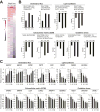Effects of Moderate and Subsequent Progressive Weight Loss on Metabolic Function and Adipose Tissue Biology in Humans with Obesity
- PMID: 26916363
- PMCID: PMC4833627
- DOI: 10.1016/j.cmet.2016.02.005
Effects of Moderate and Subsequent Progressive Weight Loss on Metabolic Function and Adipose Tissue Biology in Humans with Obesity
Abstract
Although 5%-10% weight loss is routinely recommended for people with obesity, the precise effects of 5% and further weight loss on metabolic health are unclear. We conducted a randomized controlled trial that evaluated the effects of 5.1% ± 0.9% (n = 19), 10.8% ± 1.3% (n = 9), and 16.4% ± 2.1% (n = 9) weight loss and weight maintenance (n = 14) on metabolic outcomes. 5% weight loss improved adipose tissue, liver and muscle insulin sensitivity, and β cell function, without a concomitant change in systemic or subcutaneous adipose tissue markers of inflammation. Additional weight loss further improved β cell function and insulin sensitivity in muscle and caused stepwise changes in adipose tissue mass, intrahepatic triglyceride content, and adipose tissue expression of genes involved in cholesterol flux, lipid synthesis, extracellular matrix remodeling, and oxidative stress. These results demonstrate that moderate 5% weight loss improves metabolic function in multiple organs simultaneously, and progressive weight loss causes dose-dependent alterations in key adipose tissue biological pathways.
Copyright © 2016 Elsevier Inc. All rights reserved.
Conflict of interest statement
S. Klein is a shareholder of Aspire Bariatrics and has served on scientific advisory boards for Takeda Pharmaceuticals and NovoNordisk. None of the other authors have any conflicts of interest relevant to this manuscript.
Figures


References
Publication types
MeSH terms
Substances
Grants and funding
- P30 DK092950/DK/NIDDK NIH HHS/United States
- DK104995/DK/NIDDK NIH HHS/United States
- DK 37948/DK/NIDDK NIH HHS/United States
- DK20579/DK/NIDDK NIH HHS/United States
- P30 DK056341/DK/NIDDK NIH HHS/United States
- UL1 RR024992/RR/NCRR NIH HHS/United States
- R01 DK104995/DK/NIDDK NIH HHS/United States
- UL1 TR000448/TR/NCATS NIH HHS/United States
- P60 DK020579/DK/NIDDK NIH HHS/United States
- P30 DK020579/DK/NIDDK NIH HHS/United States
- RR024992/RR/NCRR NIH HHS/United States
- R01 DK037948/DK/NIDDK NIH HHS/United States
- DK 56341/DK/NIDDK NIH HHS/United States
- KL2 TR000450/TR/NCATS NIH HHS/United States
LinkOut - more resources
Full Text Sources
Other Literature Sources
Medical
Molecular Biology Databases

